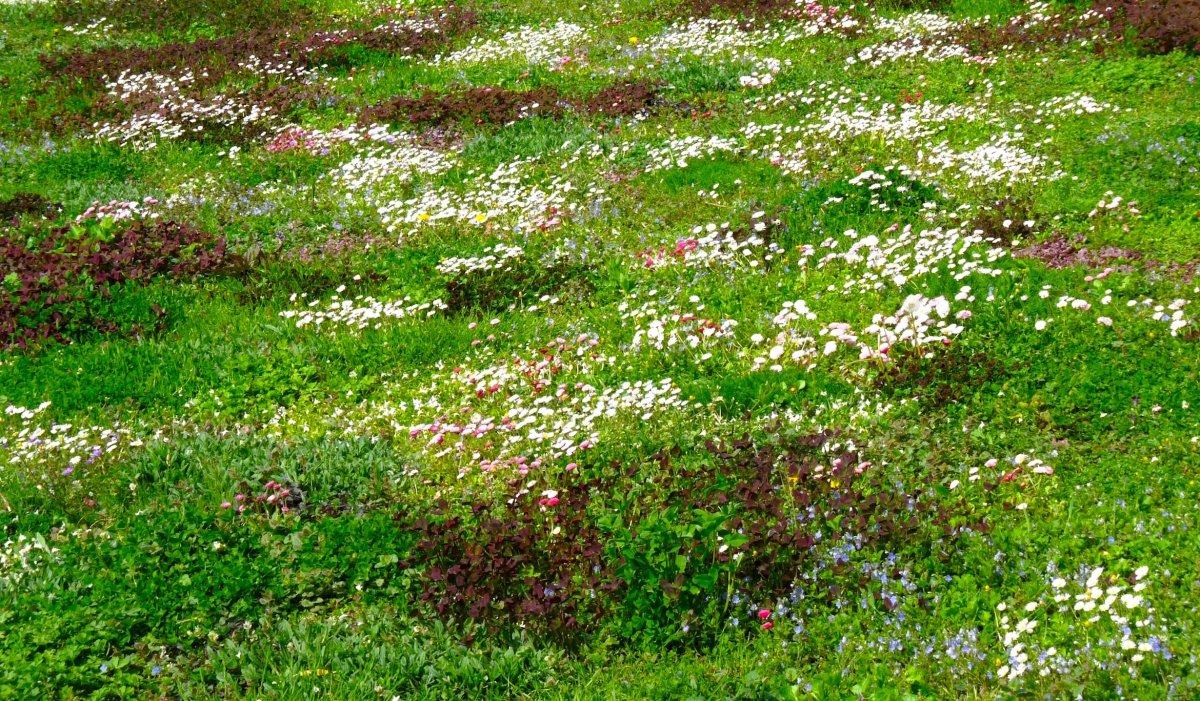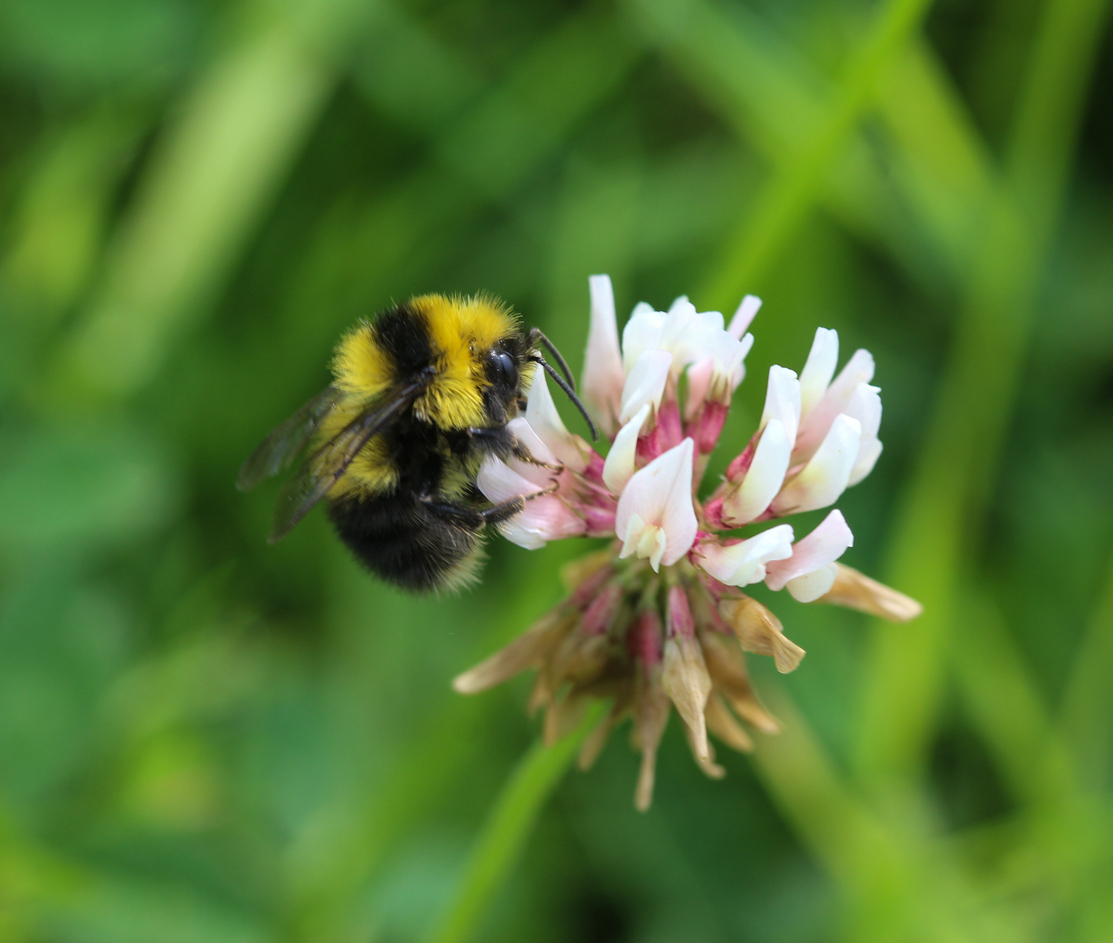

We may earn revenue from the products available on this page and participate in affiliate programs. Learn More ›
The days of relying on perfectly manicured turfgrass lawns as a status symbol are on their way out. Instead, many homeowners are turning to a new idea (developed by Dr. Lionel Smith in 2019) that’s part of the natural landscape trend.
Tapestry lawns are low-maintenance lawns that incorporate a variety of low-growing flowering perennial plants. Many horticulturists consider them closer to a native lawn. They absorb water better than traditional lawns and attract pollinators. Aesthetically, these grass-alternative lawns are colorful works of art that are sustainable and eco-friendly because they don’t require fertilization or frequent mowing.
RELATED: The Government Paid Me to Remove My Lawn—Here’s What Happened
What Is a Tapestry Lawn?
Tapestry lawns, also known as meadow lawns, matrix gardens, and patchwork lawns, incorporate low-growing flowering plants and grasses that can withstand foot traffic and mowing. Together, they create a tapestry—a woven mat—of various textures, colors, shades, and layers.
Considered a non-traditional lawn, a tapestry lawn is a low-maintenance alternative to the traditional turfgrass lawn. This blended interlacing uses native plants (perennials) that require less watering, fertilizing, and mowing—all while producing a colorful display of blooms from spring through autumn that support pollinators.
Creeping thyme and clover, plus chamomile and varieties of stonecrop are commonly used, although almost any low-growing native grass, flowering perennial, or native ground cover is suitable.
Benefits of a Tapestry Lawn

For the generations raised on turfgrass lawns, a tapestry lawn can take some getting used to. There are numerous benefits, however, which can make the transition worthwhile.
Growing a tapestry lawn can reduce the need to mow by up to two-thirds. It doesn’t need aerating, herbicides, pesticides, or fertilizers.
A native tapestry lawn can absorb rainfall twice as fast as traditional lawns. Because it provides a variety of flowers from spring through autumn, a tapestry garden—or floral lawn—supports pollinators throughout their lifetimes. In fact, it supports diversity in wildlife through its mixture of plants, unlike the monoculture of traditional turfgrass.
Furthermore, a tapestry lawn typically is:
- Eco-friendly
- Drought-resistant
- Shade-tolerant
- Affordable
- Colorful
How to Plant a Tapestry Lawn
If you’ve decided to replace your traditional turfgrass lawn with a more diverse, eco-friendly, and colorful tapestry lawn, following some basic steps can help achieve the best results.
1. Remove the old lawn.
Before you can plant a new tapestry lawn, you have to remove the existing one. The old tried-and-true method of digging out turfgrass is tedious and tiring, but remains the best way of eliminating existing grass and preventing young seedlings from taking hold.
Sheet mulching can rid the space of grass and weeds—but it takes time. Alternate layers of cardboard and mulch and wait up to 6 months. You’ll end up with great soil ready for the planting. Take note that this method works best in warm weather.
2. Prepare the soil.
Healthy plants rely on good soil. Test your soil to find out what kind of amendments it needs. Check pH and physical characteristics. It shouldn’t be too hard, sandy, or clumpy. The best soil will drain well and be slightly coarse.
Add topsoil, compost, or other organic material as needed. Then rake to level the soil and break up any clumps.
3. Choose your plants.

Select a mixture of native plants (or climate-adapted, noninvasive species) that share similar light and water requirements and that can grow in your soil type. Select low-growing plants or ground cover plants that require little to no mowing and are deer-resistant in areas where deer visit. Avoid aggressive meadow plants.
Commonly chosen plants include:
- Dutch white clover
- Creeping thyme
- Sedum
- Calex
- Bugleweed
- Liriope
- Chamomile
- Creeping phlox
For shady areas, try:
- Baby tears
- Irish moss
4. Plant them.
If you’re planting seeds, spread them evenly over the raked soil, following the spacing recommendations on the packets. If you’re using plant starts, dig a hole for each plug (a small plant) and place them individually in each hole, tamping down the ground around them. Spacing depends on the plant’s typical spread.
Cover seeds or plants lightly with soil mixed with compost.
5. Water the area.
After planting either seeds or plugs, lightly water the area to moisten the soil. For the first 2 to 3 weeks, you may need to water the area often to help the new lawn get established. How much you’ll need to water depends on the season, the temperature, the soil type, and the amount of rainfall. Be sure not to overwater until soil is saturated because it can cause seedlings to rot.
RELATED: What Is Meadowscaping and Can Your Neighbors Handle It?
Tapestry Lawn Maintenance
One of the benefits of a tapestry lawn is that it’s low-maintenance once it’s established. Initially, it may require regular watering and weeding, and even a little fertilizer.
Once the tapestry lawn grows to about 6 inches high, it’s time to mow. Set your mower on its highest setting (aim for 3 to 4 inches) or use a string trimmer for small areas. Leave the clippings on the lawn to serve as natural fertilizer.
You may not need to mow more than three or four times a year, and you should never need to water, fertilize, or aerate once a tapestry lawn is established, except in extreme drought. Expect weeding to be minimal once the plants fill in.
